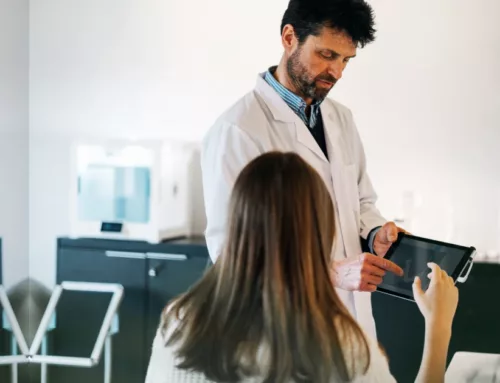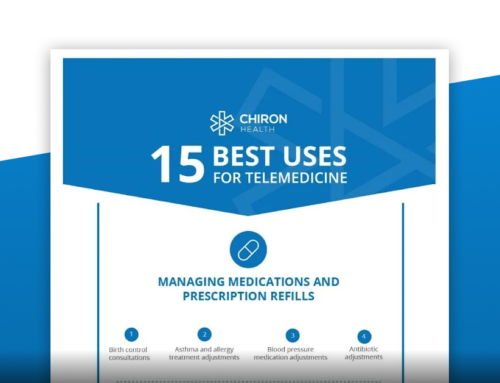So you want to get started with telemedicine, but you‘re wondering how easy it will be to integrate this new service in your practice.
An easy way to get started is to use Direct Health virtual visits for patients who need a follow up that doesn’t require a hands-on physical exam. When scheduling the follow up visit, your staff can offer telemedicine as an alternative instead of coming into your office.
Many patients will appreciate this choice because it is so convenient. And with the current recommendations for social distancing during the coronavirus pandemic, your patients will be reassured with your solution to continue taking care of them during this crisis.
Here are two clinical vignettes to illustrate how you can effortlessly begin using telemedicine.
Keeping Tabs on Cellulitis
A 41-year-old man presents in your office with a two day history of mild redness and tenderness on his calf. He says a branch scraped his leg several days ago while he was working in the yard. He denies any fever or chills, but he made the appointment to come to your office because he thinks the area of redness has gotten bigger. He has no significant past medical history other than mild hypertension well-controlled with dietary and lifestyle changes along with a low-dose ARB.
The patient is afebrile and on exam you find a 5×5 cm area of erythema and induration surrounding a healing abrasion on his right lateral calf with warmth and mild tenderness. Since you think he’s low risk for MRSA, you prescribe him a course of cephalexin, but you’d like to see him back in clinic in a few days to make sure he’s responding.
With his permission, you use a marker to outline the lesion and photograph it. You give him the option of doing his follow up via a telemedicine visit with Direct Health. He’s a busy executive who is now working from home and has concerns about exposing his 80-year-old mother to the coronavirus, so he appreciates the ability to do a remote follow up.
You’re comfortable knowing that if his cellulitis is not responding to the beta-lactam, you have the ability to send a new electronic prescription for an antibiotic with MRSA coverage after his virtual visit.
Battling Back Pain
A 35-year-old woman with no significant past medical history presents in your office with a three-day history of lower back pain. She started having pain shortly after bending over to pick up her five-year-old son, and ever since she has aching pain on her lower right side. She finds it difficult to bend and twist without exacerbating the pain. She took acetaminophen with mild relief, and she denies fevers and chills or any recent infections.
On exam the patient is afebrile and in mild distress due to her inability to sit comfortably. She has decreased lumbar flexion and extension secondary to pain, but no neurological red flags are present.
You give her a prescription dose of an NSAID along with heat and ice therapy. You also advise her to keep moving and continue with her usual activities as her pain improves.
She schedules a virtual follow up with you on Direct Health in three days, which she values because her son is home from school due to the coronavirus pandemic, making it harder for her to come see you.
Expanding Your Options with Telemedicine
In both these cases, you can easily evaluate how your patients are responding to your treatment plan.
For the cellulitis case, you’ll have the reference photo from the patient’s initial visit along with the border markings for comparison. With a video call on Direct Health, you can have your patient change the camera angle and lighting to give you a better idea of how the lesion looks.
And if you’re concerned the cellulitis may be consolidating into an abscess, you can always have your patient come to your office for further evaluation and possible drainage.
For your patient with back pain, you can quickly assess her range of motion and functional status during a Direct Health video call. And if you want to give her more information about how to manage her back pain, you can easily send her handouts through the Direct Health platform.
Many of our Direct Health users block off time in their schedule specifically for virtual visits. Using Direct Health in this way can help you see patients more efficiently with less stress. And you may find it ultimately saves you time for these types of visits.
Interested in learning more about Direct Health? Contact us to schedule a demo or sign up now.
About the Author
Stephanie Kreml, MD is a former urgent care doctor and advises digital health and life science companies. Dr. Kreml also served as Chief Medical Officer for Accordion Health where she worked alongside data scientists to develop machine learning-based tools to enable healthcare organizations more effectively manage their patient populations.
She is an Advisory Panel Member for Dell Medical School’s Texas Health Catalyst program, enabling researchers to translate technologies into commercial healthcare applications. Prior to medical school, she held engineering positions with Motorola and Texas Instruments. Dr. Kreml received her Doctor of Medicine from Baylor College of Medicine and her Bachelor of Science in Electrical Engineering from The University of Texas at Austin.
About Direct Health
Direct Health is working to change how healthcare is delivered by recreating the doctor-patient relationship. With the secure messaging app, physicians and patients have the ability to connect via text, call, or video, from anywhere and on their schedule. This enables patients to chat with their doctor, vet, or therapist at any time, and clinicians to extend care and get paid without extra overhead or burdensome schedules. With over 20,000 doctors across the platform, Direct Health is leading the way in the future of healthcare. For more information, visit http://www.directhealth.us.






Leave A Comment